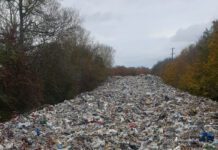Steve Mustow of WYG on why we need to ensure that nutrient pollution control doesn’t stand in the way of new development while continuing to protect sensitive aquatic environments.
In several sensitive catchments in England that include Natura 2000 sites, where there is a threat of nutrient pollution from diffuse and point sources, Nutrient Management Plans (NMPs) have been put in place by the Environment Agency and Natural England.
The primary legislative driver for producing NMPs for Natura 2000 sites is to provide evidence for Habitats Regulations Assessments which may be required in relation to development plans and reviews of discharge consents. A secondary driver is to provide evidence to underpin the strategy to achieve the wider Habitats Directive, Birds Directive and Water Framework Directive targets.
Natural England has established an Improvement Programme for Natura 2000 sites (IPENS) and this has developed a Site Improvement Plan (SIP) for each Natura 2000 site. Eight of these site improvement plans include an NMP. These provide a mechanism for tackling water pollution where excessive phosphorus and or nitrogen loading requires a combined approach that addresses point discharges and diffuse sources.
Examples of Natura 2000 sites with an NMP include the River Avon, River Wye, River Clun and River Mease Special Areas of Conservation (SACs) and Poole Harbour Special Protection Area (SPA). At the River Avon SAC, phosphorus is preventing favourable conservation status being achieved across the catchment, while the River Wye SAC has reaches where the levels of phosphate exceed the target level in the conservation objectives.
The River Clun is designated as a SAC for freshwater pearl mussel. However, surveys since 1995 have shown that the population of freshwater pearl mussel is non-functioning due to pollution issues from phosphorus, nitrogen and sediment. Meanwhile, the River Mease SAC’s excessive levels of phosphate are preventing the achievement of favourable condition, and at Poole Harbour SPA, increasing nitrogen levels from sewage and agriculture are contributing to the growth of algal mats in the harbour, restricting food for wading birds and smothering estuarine habitats.
Curbing pollution problems
Examples of the pollution control measures in the above NMPs include measures at both point sources and diffuse sources. At point sources, measures include upgrading sewage treatment works to strip out nutrients; reducing phosphorus emissions from fish farms and cress farms; preventing infiltration to the sewer network; reducing discharges from Combined Sewer Overflows (CSOs) and examining the potential to retrofit Sustainable Urban Drainage Systems (SUDS).
For diffuse sources, there are a range of agri-environmental and other measures such as integrated soil, water and nutrient management plans for farms; encouraging the use of winter storage reservoirs within the horticultural sector; reverting to semi natural vegetation; and rectifying sewer misconnections.
Barriers to development
The need to limit nutrient discharges through an NMP is a potential barrier to new development, including construction of housing and infrastructure in these catchments, particularly where it would increase nutrient loads in sewage. This is a particular concern given the urgent need for new housing in the UK. However, developments can still proceed if the resulting nutrients can be removed at the sewage treatment works or be offset through measures to reduce diffuse pollution, such as from farming.
Examples of potential restrictions posed by the above NMPs and the measures put in place to facilitate development are outlined below.
The NMP for the River Avon originally allowed development within the existing headroom of sewage treatment works. However, the Environment Agency and Natural England subsequently advised that development must be phosphate neutral as targets in the NMP were unlikely to be met by 2021. To help facilitate development, post 2025 it is assumed that upgraded sewage treatment works will remove additional phosphorus. A joint Memorandum of Understanding between the statutory authorities provides for interim mitigation which will be funded primarily through the Community Infrastructure Levy (CIL) paid by developers.
In the Memorandum of Understanding, the local planning authorities commit to a precautionary approach and to put in place measures to remove, mitigate or offset the phosphate load from qualifying developments. The measures operate within the legal and policy framework of the planning system, such as governing the use of planning conditions, CIL and Section 106 obligations. An annex to the NMP is due to be published providing details of the mitigation measures and monitoring arrangements.
At the River Mease, new development can only take place if it contributes to the Developer Contribution Scheme so as to be phosphate neutral. Developer Contribution Scheme contributions from residential development coming forward in the first development window are calculated by the size of the dwelling and how sustainable it is.
At Poole Harbour, new development can only take place if it mitigates 25% of the additional nitrogen it produces (Wessex Water is expected to remove the other 75% at sewage treatment works). A supplementary planning document (SPD) lays out the process for councils to secure mitigation from CIL and Section 106 agreements.
The SPD provides example calculations of nitrate loads for different development types and mitigation options. The developer has up to four choices for the Section 106 agreement, including to provide alternative technologies to remove the remaining nitrogen, increase the size of Suitable Alternative Natural Greenspaces (SANGs) on agricultural land, agree with the council a change to the management of agricultural land in the wider landholding in perpetuity, and/or purchase agricultural land elsewhere within the catchment and use it for mitigation.
Clearer guidelines needed
In conclusion, upgrading sewage treatment works is a particularly effective measure for removing the additional nutrients, but this relies on the asset management plan process and developers are not allowed to make financial contributions to bring upgrades forward. Therefore, the establishment of specific schemes to facilitate development, such as those for the River Mease, the River Avon and Poole Harbour are important.
These schemes also support measures to tackle diffuse pollution which could prove critical in the longer term and are often relatively low cost, in terms of both money and carbon emissions.
Nutrient management is very important for protecting European sites threatened by nutrient pollution. However, there can still be an unclear and complicated situation for developers depending on the site in question and the approach of the regulators. This could restrain development of new housing and non-residential development. More still needs to be done to ensure there is limited economic and social impact.







